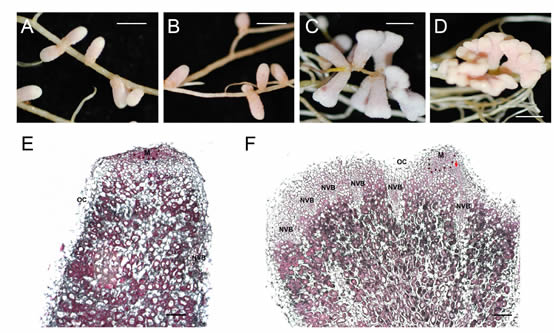Prof. Christian Staehelin's group at the School of Life Sciences revealed a role of a legume enzyme cleaving nodulation signals of nitrogen-fixing bacteria
Source: School of Life Sciences
Written by: School of Life Sciences
Edited by: Jin Feng
Prof. Christian Staehelin's group at the School of Life Sciences has published an article entitled "Role of the Nod Factor Hydrolase MtNFH1 in Regulating Nod Factor Levels during Rhizobial Infection and in Mature Nodules of Medicago truncatula " in the prestigious journal The Plant Cell (IF5-years = 9.996). The results of this study indicate that fine-tuning of Nod factor levels by MtNFH1 promotes root hair infection of nitrogen-fixing rhizobia as well as growth of mature root nodules of the legume Medicago truncatula. Dr. Jie Cai, Postdoctoral Research Associate, is the first author of this paper, while Prof. Zhi-Ping Xie and Prof. Christian Staehelin are the corresponding authors of this study.

Nodulation phenotype of wild-type plants (A, B, E) and of the mutant deficient in MtNFH1 (C, D, F)
Nitrogen-fixing rhizobia are symbiotic bacteria that convert atmospheric nitrogen gas into ammonia in root nodules of legumes. The fixed nitrogen is provided to the host plant in exchange for photosynthesis products and nutrients. Rhizobia typically enter young legume roots via infection of root-hairs. Establishment of symbiosis depends on rhizobial nodulation signals, the so-called Nod factors (chitin oligosaccharides modified with a fatty acid chain). Legumes possess chitinases (chitin cleaving enzymes) or related hydrolases that can cleave Nod factors. In this way, the host plant controls Nod factor levels at the symbiotic interface. Prof. Staehelin's group has previously identified MtNFH1, a Nod factor hydrolase of the legume Medicago truncatula. This enzyme lacks chitinase activity but efficiently cleaves Nod factors produced by Sinorhizobium meliloti. In the current article, they provide evidence for a role of MtNFH1 in the symbiosis with S. meliloti. Upon rhizobial inoculation, MtNFH1 accumulated at the curled tip of root hairs, in the so-called infection chamber. Prof. Staehelin's group have identified and characterized M. truncatula mutant plants that do not produce MtNFH1. When inoculated with S. meliloti, the mutant plants showed delayed root-hair infection as compared to wild-type plants. Hence, MtNFH1 possesses a symbiosis-promoting role at the stage of bacterial entry into roots. Surprisingly, the MtNFH1-deficient plants formed nodules that were different from wild-type nodules. Nodules of mutant plants were bigger and frequently clustered together. Remarkably, young nodules of mutant plants showed abnormal nodule branching (see photo). Such nodule branching was also observed for wild-type plants inoculated by a Nod factor overproducing S. meliloti strain. In conclusion, the published data indicate that Nod factor hydrolysis plays an important role in the fine-tuning of the symbiosis at the stage of root-hair infection and in nitrogen-fixing nodules.
Link to the article: http://www.plantcell.org/content/early/2018/01/24/tpc.17.00420
